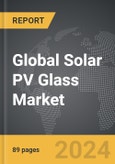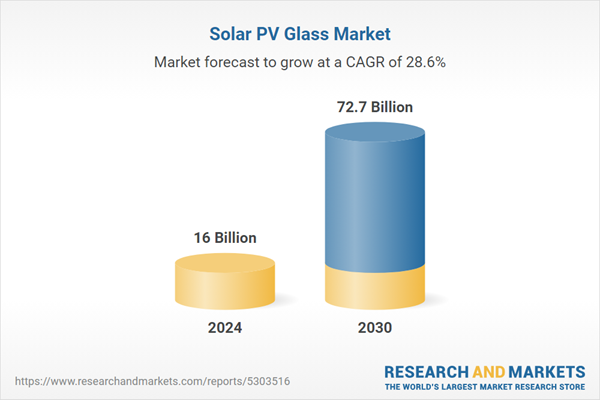Global Solar PV Glass Market - Key Trends & Drivers Summarized
Empowering Next-Generation Solar Modules: How Solar PV Glass Is Optimizing Performance and Energy YieldWhat Is Solar PV Glass and Why Is It a Critical Component in Photovoltaic Technology Advancement?
Solar PV glass is a specially manufactured glass used to encapsulate, protect, and enhance the performance of photovoltaic (PV) cells in solar modules. It serves as the front cover of a solar panel, offering transparency for maximum light transmission while shielding the cells from moisture, temperature fluctuations, mechanical impact, and environmental degradation. Beyond its basic protective function, modern PV glass is engineered with anti-reflective coatings, self-cleaning surfaces, UV filtration, and sometimes even bifacial transmission capabilities that directly influence the efficiency, reliability, and lifespan of the solar panel. As the global solar power sector pushes toward higher energy yields and longer operational lifespans, the performance attributes of PV glass are becoming more integral to module competitiveness.Low-iron, tempered glass is the industry standard for solar applications due to its superior optical clarity and mechanical resilience. Glass thickness typically ranges from 2.0 to 3.2 mm, with advances in ultra-thin and chemically strengthened glass offering weight reductions without compromising strength. In bifacial modules, where light is captured from both the front and rear sides, glass-glass configurations using solar PV glass on both surfaces enhance structural integrity and environmental protection. These configurations also facilitate higher energy generation in diffused light conditions and dual-axis installations. As solar moves into next-generation segments such as building-integrated photovoltaics (BIPV), agrivoltaics, and floating PV, PV glass is being customized for transparency, aesthetic adaptability, and increased corrosion resistance.
Which Applications and Design Variants Are Shaping the Demand Landscape for Solar PV Glass?
Crystalline silicon PV modules continue to account for the majority of global solar deployments, and nearly all of them use solar PV glass as the top sheet. Demand is particularly robust in utility-scale solar farms, where module durability and anti-soiling characteristics are essential to maintaining long-term output. Glass manufacturers are incorporating anti-reflective and hydrophobic nanocoatings to improve light absorption and reduce dust accumulation-especially in desert regions where cleaning cycles are labor-intensive and water-intensive. Dual-glass bifacial modules are now favored in harsh environments such as arid zones, coastal installations, and high-altitude arrays due to their resistance to potential-induced degradation (PID) and reduced microcracking.Solar PV glass is also gaining prominence in BIPV applications, where aesthetics and structural requirements are critical. Developers are demanding semi-transparent, colored, or patterned solar glass that can double as façades, windows, or skylights without compromising architectural vision. This niche segment is supported by innovations in encapsulation materials and optical tuning, allowing buildings to generate electricity while maintaining natural lighting and thermal regulation. Agrivoltaics represents another expanding market segment where PV glass is designed to transmit specific wavelengths beneficial to plant growth while reflecting harmful UV rays. These spectrally selective glasses balance agricultural productivity with solar energy generation in dual-use land settings.
Floating PV systems require corrosion-resistant and lightweight PV glass capable of withstanding high humidity, saltwater exposure, and wind stress. Manufacturers are responding with specialized glass compositions and edge-sealing technologies that enhance performance in marine and freshwater installations. Moreover, PV glass is increasingly being explored in off-grid applications such as solar-powered greenhouses, water pumping stations, and microgrid-powered community centers-where reliable, high-transmission glass is essential to ensure modular efficiency and system uptime.
Which Countries Dominate Production and How Are Regional Policies Influencing Market Trends?
China is the undisputed leader in solar PV glass production, accounting for more than 75% of global supply. Chinese manufacturers like Xinyi Solar, Flat Glass Group, and IRICO have established massive production capacities, often integrating upstream with float glass manufacturing and downstream with solar module assembly. China-s strategic support for solar glass includes favorable financing, export incentives, and domestic demand driven by its ambitious renewable energy targets. The country-s “Top Runner Program” has incentivized high-efficiency module adoption, which in turn accelerates demand for premium PV glass with advanced coatings and bifacial compatibility.India is rapidly building domestic solar glass manufacturing capacity under the Production Linked Incentive (PLI) scheme to reduce dependence on imports and meet the rising demand from domestic module makers. Europe, particularly Germany and Spain, is witnessing increased interest in solar glass manufacturing due to regulatory pushes for supply chain resilience and carbon neutrality. The EU-s push for energy independence and its Carbon Border Adjustment Mechanism (CBAM) are driving new investments in low-emission glass production, including electrified furnaces and recycled raw material usage.
In North America, the U.S. is experiencing a resurgence in solar manufacturing through the Inflation Reduction Act (IRA), which provides tax incentives and procurement mandates for domestically produced components, including PV glass. Southeast Asia is emerging as a secondary production hub, particularly in Malaysia and Vietnam, where solar OEMs are locating new factories to serve global markets amid U.S.-China trade tensions. Meanwhile, Middle Eastern countries like the UAE and Saudi Arabia are exploring PV glass production as part of their solar mega-projects and industrial diversification strategies.
What Is Driving the Market-s Growth and Where Are the Opportunities for Innovation?
The growth in the solar PV glass market is driven by several factors including surging solar installations, rising demand for bifacial and BIPV modules, and continuous innovation in glass coatings and structure. As global energy systems decarbonize, the demand for high-efficiency, durable, and aesthetically adaptive PV modules is rising sharply, directly boosting the market for specialized glass. Declining glass thickness, improved light trapping, and spectral optimization are helping module manufacturers push cell efficiency toward and beyond the 25% mark-making PV glass a critical lever in performance gains.Future innovations in PV glass will focus on lightweight glass for transport and rooftop applications, anti-microbial and self-healing coatings, and dynamic electrochromic properties that enable adaptive transparency. The integration of PV glass into smart city infrastructure-such as solar bus stops, power-generating façades, and solar-powered transit shelters-is also expected to unlock new use cases. Additionally, the rise of circular economy practices will drive demand for recyclable and low-carbon glass compositions, supported by traceability and life cycle assessment (LCA) data.
As global solar deployment crosses 1 terawatt of installed capacity and targets several-fold expansion by 2030, solar PV glass will remain indispensable to module performance, durability, and aesthetics. Backed by large-scale manufacturing, policy support, and technological refinement, the solar PV glass market is set to thrive as a foundational component of the global energy transition.
Scope Of Study:
The report analyzes the Solar PV Glass market in terms of units by the following Segments, and Geographic Regions/Countries:Segments: Type (TCO Coated Solar PV Glass, AR Coated Solar PV Glass, Tempered Solar PV Glass, Other Solar PV Glasses); Installation (Patterned Glass Technology Installation, Float Glass Technology Installation); End-Use (Residential End-Use, Commercial End-Use, Industrial End-Use, Utility End-Use, Other End-Uses)
Geographic Regions/Countries: World; United States; Canada; Japan; China; Europe (France; Germany; Italy; United Kingdom; Spain; Russia; and Rest of Europe); Asia-Pacific (Australia; India; South Korea; and Rest of Asia-Pacific); Latin America (Argentina; Brazil; Mexico; and Rest of Latin America); Middle East (Iran; Israel; Saudi Arabia; United Arab Emirates; and Rest of Middle East); and Africa.
Key Insights:
- Market Growth: Understand the significant growth trajectory of the TCO Coated Solar PV Glass segment, which is expected to reach US$36.9 Billion by 2030 with a CAGR of a 31.6%. The AR Coated Solar PV Glass segment is also set to grow at 24.1% CAGR over the analysis period.
- Regional Analysis: Gain insights into the U.S. market, estimated at $4.4 Billion in 2024, and China, forecasted to grow at an impressive 37.9% CAGR to reach $18.5 Billion by 2030. Discover growth trends in other key regions, including Japan, Canada, Germany, and the Asia-Pacific.
Why You Should Buy This Report:
- Detailed Market Analysis: Access a thorough analysis of the Global Solar PV Glass Market, covering all major geographic regions and market segments.
- Competitive Insights: Get an overview of the competitive landscape, including the market presence of major players across different geographies.
- Future Trends and Drivers: Understand the key trends and drivers shaping the future of the Global Solar PV Glass Market.
- Actionable Insights: Benefit from actionable insights that can help you identify new revenue opportunities and make strategic business decisions.
Key Questions Answered:
- How is the Global Solar PV Glass Market expected to evolve by 2030?
- What are the main drivers and restraints affecting the market?
- Which market segments will grow the most over the forecast period?
- How will market shares for different regions and segments change by 2030?
- Who are the leading players in the market, and what are their prospects?
Report Features:
- Comprehensive Market Data: Independent analysis of annual sales and market forecasts in US$ Million from 2024 to 2030.
- In-Depth Regional Analysis: Detailed insights into key markets, including the U.S., China, Japan, Canada, Europe, Asia-Pacific, Latin America, Middle East, and Africa.
- Company Profiles: Coverage of players such as AGC Glass Europe, AGC Inc., Coresix, CSG Holding Limited, First Solar and more.
- Complimentary Updates: Receive free report updates for one year to keep you informed of the latest market developments.
Some of the 44 companies featured in this Solar PV Glass market report include:
- AGC Glass Europe
- AGC Inc.
- Coresix
- CSG Holding Limited
- First Solar
- Flat Glass Group
- IRICO Group
- JinkoSolar
- LONGi Green Energy Technology
- Nippon Electric Glass Co., Ltd.
- Nippon Sheet Glass Co., Ltd.
- Onyx Solar
- Saint-Gobain
- Schott AG
- Sisecam
- Solarcycle (recycled solar glass)
- Taiwan Glass Industry Corporation
- Targray
- Trina Solar
- Xinyi Solar Holdings Limited
This edition integrates the latest global trade and economic shifts as of June 2025 into comprehensive market analysis. Key updates include:
- Tariff and Trade Impact: Insights into global tariff negotiations across 180+ countries, with analysis of supply chain turbulence, sourcing disruptions, and geographic realignment. Special focus on 2025 as a pivotal year for trade tensions, including updated perspectives on the Trump-era tariffs.
- Adjusted Forecasts and Analytics: Revised global and regional market forecasts through 2030, incorporating tariff effects, economic uncertainty, and structural changes in globalization. Includes segmentation by product, technology, type, material, distribution channel, application, and end-use, with historical analysis since 2015.
- Strategic Market Dynamics: Evaluation of revised market prospects, regional outlooks, and key economic indicators such as population and urbanization trends.
- Innovation & Technology Trends: Latest developments in product and process innovation, emerging technologies, and key industry drivers shaping the competitive landscape.
- Competitive Intelligence: Updated global market share estimates for 2025, competitive positioning of major players (Strong/Active/Niche/Trivial), and refined focus on leading global brands and core players.
- Expert Insight & Commentary: Strategic analysis from economists, trade experts, and domain specialists to contextualize market shifts and identify emerging opportunities.
- Complimentary Update: Buyers receive a free July 2025 update with finalized tariff impacts, new trade agreement effects, revised projections, and expanded country-level coverage.
Table of Contents
Companies Mentioned (Partial List)
A selection of companies mentioned in this report includes, but is not limited to:
- AGC Glass Europe
- AGC Inc.
- Coresix
- CSG Holding Limited
- First Solar
- Flat Glass Group
- IRICO Group
- JinkoSolar
- LONGi Green Energy Technology
- Nippon Electric Glass Co., Ltd.
- Nippon Sheet Glass Co., Ltd.
- Onyx Solar
- Saint-Gobain
- Schott AG
- Sisecam
- Solarcycle (recycled solar glass)
- Taiwan Glass Industry Corporation
- Targray
- Trina Solar
- Xinyi Solar Holdings Limited
Table Information
| Report Attribute | Details |
|---|---|
| No. of Pages | 383 |
| Published | December 2025 |
| Forecast Period | 2024 - 2030 |
| Estimated Market Value in 2024 | 16 Billion |
| Forecasted Market Value by 2030 | 72.7 Billion |
| Compound Annual Growth Rate | 28.6% |
| Regions Covered | Global |









